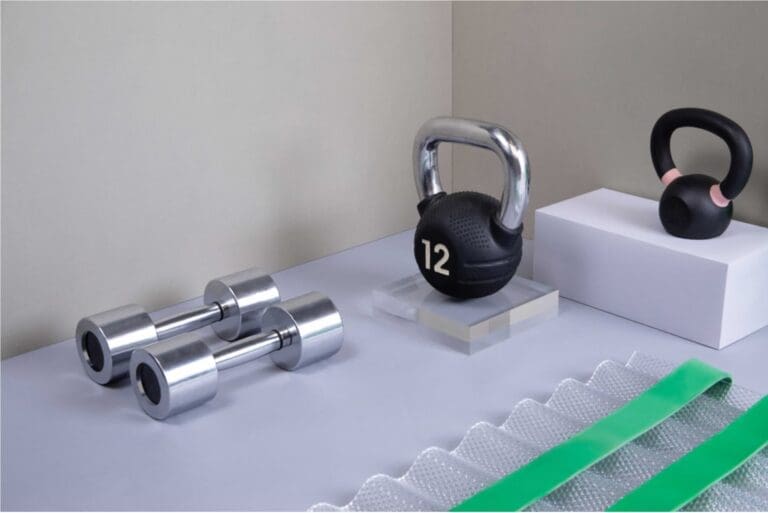We independently review everything we recommend. When you buy through our links, we may earn a commission. Learn more›
Introduction
Hey there, fitness enthusiasts! Holly Roser here from Holly Roser Fitness in the heart of San Francisco. Today, we’re diving deep into a topic that’s been buzzing in the fitness world: interval training. If you’ve been looking for a way to supercharge your workouts and see real results in both your cardiovascular fitness and fat loss journey, you’re in for a treat.
Interval training isn’t just another fitness fad – it’s a scientifically backed method that’s been shown to deliver impressive results in less time than traditional steady-state cardio. But what exactly is interval training, and why is it so effective? That’s what we’re here to unpack.
In this blog post, we’ll explore the science behind interval training, break down how it affects your body, and give you practical tips on how to incorporate it into your fitness routine. Whether you’re a seasoned athlete or just starting your fitness journey, there’s something here for everyone. So, let’s lace up those sneakers and get ready to learn about one of the most efficient ways to boost your fitness game!
What is Interval Training?
Definition and Basic Concept
Interval training is a type of workout that alternates between periods of high-intensity exercise and periods of lower-intensity recovery or rest. It’s like a roller coaster for your heart rate – you push hard, then ease off, then push hard again. This back-and-forth creates a unique stress on your body that can lead to impressive fitness gains.
The beauty of interval training lies in its versatility. It can be applied to almost any form of exercise – running, cycling, swimming, or even bodyweight exercises. The key is in the intensity variation, not necessarily the specific activity.
Types of Interval Training
There are several types of interval training, each with its own unique benefits:
- High-Intensity Interval Training (HIIT): This involves short bursts of all-out effort followed by brief recovery periods. A typical HIIT session might involve 30 seconds of sprinting followed by 30 seconds of walking, repeated for 15-20 minutes.
- Sprint Interval Training (SIT): Similar to HIIT, but with even shorter, more intense work periods. Think 20-30 second all-out sprints followed by longer recovery periods.
- Tabata: A specific form of HIIT that involves 20 seconds of maximum effort followed by 10 seconds of rest, repeated for 4 minutes.
- Fartlek Training: Swedish for “speed play,” this type of training involves alternating between fast and slow speeds during a continuous run.
- Pyramid Intervals: These involve gradually increasing the intensity and duration of work periods, then decreasing them, creating a pyramid-like structure.
Each type has its place in a well-rounded fitness program, and the best choice depends on your fitness level, goals, and preferences.
The Science Behind Interval Training
Physiological Responses to Interval Training
When you engage in interval training, your body undergoes a series of fascinating physiological changes. Let’s break down what’s happening under the hood:
- Increased Oxygen Consumption: During high-intensity intervals, your body’s oxygen demand skyrockets. This creates an “oxygen debt” that your body continues to repay even after the workout is over, leading to increased calorie burn post-exercise.
- Anaerobic Threshold Improvement: Regular interval training can push your anaerobic threshold higher, allowing you to work at higher intensities for longer periods before fatigue sets in.
- Mitochondrial Adaptations: Interval training stimulates the production of more mitochondria in your muscle cells. These cellular powerhouses are responsible for energy production, making your muscles more efficient.
- Hormone Response: High-intensity exercise triggers the release of growth hormone and other anabolic hormones that aid in muscle growth and fat metabolism.
Metabolic Impact
The metabolic impact of interval training is where things get really interesting. A study published in the Journal of Obesity in 2021 found that high-intensity interval training was more effective at reducing total body fat and trunk fat compared to moderate-intensity continuous training, even when the total energy expenditure of the workouts was matched (Zhang et al., 2021).
This increased fat-burning effect is partly due to the “afterburn” effect, officially known as Excess Post-exercise Oxygen Consumption (EPOC). EPOC refers to the increased rate of oxygen intake following strenuous activity as your body works to restore itself to its pre-exercise state. This process can elevate your metabolism for hours after your workout, leading to increased calorie burn long after you’ve left the gym.
“HIIT appears to induce superior improvements in CRF [cardiorespiratory fitness] when compared to MICT [moderate-intensity continuous training], in healthy adults” (Sabag et al., 2022).
This quote from a comprehensive meta-analysis published in Sports Medicine highlights another key benefit of interval training – its superior effect on cardiovascular fitness compared to traditional steady-state cardio.
Cardiovascular Benefits of Interval Training
Improved Heart Health
Interval training isn’t just about burning calories – it’s a powerhouse for improving your cardiovascular health. Here’s how:
- Enhanced Heart Strength: The alternating high and low intensities of interval training challenge your heart to become more efficient at pumping blood.
- Improved Stroke Volume: This is the amount of blood your heart pumps with each beat. Interval training can increase this, making your heart more efficient.
- Better Endothelial Function: The endothelium is the inner lining of your blood vessels. Interval training improves its function, leading to better blood flow and lower blood pressure.
Increased VO2 Max
VO2 max is a measure of the maximum amount of oxygen your body can utilize during intense exercise. It’s considered one of the best indicators of cardiovascular fitness. Interval training has been shown to be particularly effective at improving VO2 max.
A study published in Medicine & Science in Sports & Exercise found that after 8 weeks of high-intensity interval training, participants increased their VO2 max by an average of 3.6 mL/kg/min, a significant improvement in cardiovascular fitness (Wen et al., 2019).
Blood Pressure Regulation
Interval training can also play a role in managing blood pressure. The intense bursts of activity followed by recovery periods create a unique stress on your cardiovascular system that can lead to improvements in blood pressure regulation.
Fat Loss and Body Composition Changes
Mechanisms of Fat Loss in Interval Training
Interval training is a potent tool for fat loss, and here’s why:
- Increased Caloric Burn: The high-intensity nature of interval training burns more calories in a shorter time compared to steady-state cardio.
- EPOC Effect: As mentioned earlier, the afterburn effect continues to burn calories post-workout.
- Fat Oxidation: Interval training enhances your body’s ability to use fat as fuel, both during and after exercise.
- Appetite Regulation: Some studies suggest that high-intensity exercise may help suppress appetite, making it easier to maintain a calorie deficit.
Impact on Body Composition
Interval training doesn’t just help you lose weight – it can help you lose fat while preserving or even building muscle mass. This leads to positive changes in body composition, often resulting in a leaner, more toned physique.
A study published in the Journal of Obesity found that participants who engaged in high-intensity interval training for 12 weeks lost significantly more body fat, particularly abdominal and trunk fat, compared to those who did moderate-intensity continuous training (Zhang et al., 2021).
Implementing Interval Training in Your Fitness Routine
Getting Started with Interval Training
Ready to give interval training a try? Here’s how to get started:
- Start Slow: If you’re new to high-intensity exercise, begin with shorter work periods and longer rest periods. For example, try 15 seconds of high intensity followed by 45 seconds of recovery.
- Choose Your Activity: Pick an exercise you enjoy – it could be running, cycling, swimming, or even bodyweight exercises like burpees or mountain climbers.
- Warm Up: Always start with a proper warm-up to prepare your body for the intense work ahead.
- Listen to Your Body: Push yourself, but not to the point of exhaustion or pain. It’s okay to adjust the intensity or duration as needed.
- Gradually Increase Intensity: As you get fitter, you can increase the duration of your work periods and decrease rest periods.
Sample Interval Training Workouts
Here are a few interval workouts to get you started:
- Beginner HIIT Workout:
- Warm-up: 5 minutes of light jogging
- Main Set: 10 rounds of 30 seconds high intensity, 60 seconds recovery
- Cool-down: 5 minutes of light jogging and stretching
- Intermediate Tabata Workout:
- Warm-up: 5 minutes of dynamic stretching
- Main Set: 4 minutes of 20 seconds high intensity, 10 seconds rest (repeat 2-3 times with different exercises)
- Cool-down: 5 minutes of light cardio and stretching
- Advanced Sprint Interval Training:
- Warm-up: 10 minutes of light jogging and dynamic stretches
- Main Set: 6-8 rounds of 30 seconds all-out sprint, 90 seconds recovery
- Cool-down: 10 minutes of light jogging and stretching
Remember, these are just starting points. Feel free to adjust based on your fitness level and goals. And if you’re looking for personalized guidance, don’t hesitate to book a consultation with us at Holly Roser Fitness. We’d be happy to create a custom interval training program tailored to your specific needs and goals.
Safety Considerations and Precautions
While interval training can be incredibly effective, it’s also intense. Here are some safety tips to keep in mind:
- Get a Medical Clearance: If you have any pre-existing health conditions or are new to exercise, consult with your doctor before starting an interval training program.
- Proper Form is Crucial: Maintain good form throughout your workouts to prevent injuries. If you’re unsure about proper form, consider working with a personal trainer.
- Stay Hydrated: Drink plenty of water before, during, and after your workouts.
- Don’t Overdo It: Start with 1-2 interval sessions per week and gradually increase as your fitness improves.
- Allow for Recovery: Give your body time to recover between high-intensity workouts. Mix interval training with other forms of exercise and rest days.
Combining Interval Training with Other Fitness Modalities
Strength Training and Interval Training
Combining interval training with strength training can lead to impressive results in both cardiovascular fitness and muscle strength. Here’s how you can do it:
- Alternating Days: Do interval training on one day and strength training on another.
- Same-Day Training: If you’re short on time, you can do a strength workout followed by a short interval session.
- Circuit Training: Create a circuit that alternates between strength exercises and high-intensity cardio bursts.
Remember, recovery is crucial when combining these intense forms of exercise. Listen to your body and adjust your training volume as needed.
Nutrition and Interval Training
To get the most out of your interval training, pair it with proper nutrition:
- Pre-Workout Nutrition: Eat a small meal containing carbs and protein about 1-2 hours before your workout to fuel your session.
- Post-Workout Nutrition: Replenish with a combination of protein and carbs within 30 minutes after your workout to support recovery.
- Stay Hydrated: Drink water throughout the day and during your workout to maintain performance.
- Balance Your Diet: Ensure you’re getting a good balance of proteins, carbs, and healthy fats to support your training and recovery.
Common Myths and Misconceptions about Interval Training
Let’s clear up some common misunderstandings about interval training:
- Myth: Interval training is only for athletes.
Truth: While athletes certainly benefit from interval training, it can be adapted for all fitness levels.
- Myth: You need special equipment for interval training.
Truth: While equipment can add variety, you can do effective interval training with just your body weight.
- Myth: Interval training is dangerous for your heart.
Truth: When done correctly and progressively, interval training can actually improve heart health. However, always consult with a doctor if you have pre-existingheart conditions.
- Myth: You can’t build muscle with interval training.
Truth: While it’s primarily a cardiovascular exercise, certain types of interval training can help maintain or even build muscle mass.
- Myth: More is always better with interval training.
Truth: Quality over quantity is key. Too much high-intensity work can lead to overtraining and burnout.
Conclusion
Interval training is a powerful tool in your fitness arsenal. It offers a time-efficient way to improve your cardiovascular fitness, accelerate fat loss, and enhance overall health. The science is clear: the alternating periods of high and low intensity create unique stresses on your body that lead to superior adaptations compared to steady-state exercise.
Remember, while interval training is highly effective, it’s just one piece of the puzzle. A well-rounded fitness program should include a mix of interval training, strength training, and steady-state cardio, along with proper nutrition and adequate rest.
As with any new exercise program, it’s important to start gradually and listen to your body. If you’re new to interval training or have any health concerns, it’s always a good idea to consult with a fitness professional or your healthcare provider before getting started.
At Holly Roser Fitness, we’re passionate about helping our clients in San Francisco and beyond achieve their fitness goals through evidence-based training methods like interval training. Whether you’re looking to lose fat, improve your cardiovascular health, or just shake up your fitness routine, interval training could be the game-changer you’ve been looking for.
Call to Action
Ready to take your fitness to the next level with interval training? Don’t go it alone! At Holly Roser Fitness, we specialize in creating personalized fitness plans that incorporate the latest science in exercise physiology, including interval training.
Book a free consultation with us today, and let’s create a custom interval training program that fits your goals, schedule, and fitness level. Whether you’re in the Bay Area or joining us virtually, we’re here to guide you every step of the way.
Remember, your fitness journey is unique, and having a knowledgeable guide can make all the difference. Let’s work together to unlock your full potential through the power of interval training!
And hey, if you’re still on the fence about interval training, just remember: it’s like playing tag with your fitness goals – you sprint towards them, take a breather, and then chase after them again. Who said getting fit can’t be fun?
Recommended Products for Interval Training
To enhance your interval training, consider these carefully selected products:
| Gymboss Interval Timer – Perfect for timing your work and rest periods accurately | $20.95 at Amazon |
| SPRI Jump Rope – An excellent tool for high-intensity cardio intervals | $13.51 at Amazon |
| Fit Simplify Resistance Loop Exercise Bands – Versatile for both strength and cardio intervals | $9.45 at Amazon |
Recommended Reading
| “The One Minute Workout” by Martin Gibala – Discover the science behind high-intensity interval training | $29.89 on Amazon |
| “HIIT: High Intensity Interval Training Explained” by James Driver – A comprehensive guide to incorporating HIIT into your fitness routine | $11.99 on Amazon |
References
- Zhang, H., Tong, T. K., Qiu, W., Zhang, X., Zhou, S., Liu, Y., & He, Y. (2021). Comparable Effects of High-Intensity Interval Training and Prolonged Continuous Exercise Training on Abdominal Visceral Fat Reduction in Obese Young Women. Journal of Diabetes Research, 2021, 1-9. https://doi.org/10.1155/2021/6635917
- Sabag, A., Little, J. P., & Johnson, N. A. (2022). Low-volume high-intensity interval training for cardiometabolic health. The Journal of Physiology, 600(5), 1013-1026. https://doi.org/10.1113/JP281210
- Wen, D., Utesch, T., Wu, J., Robertson, S., Liu, J., Hu, G., & Chen, H. (2019). Effects of different protocols of high intensity interval training for VO2max improvements in adults: A meta-analysis of randomised controlled trials. Journal of Science and Medicine in Sport, 22(8), 941-947. https://doi.org/10.1016/j.jsams.2019.01.013









